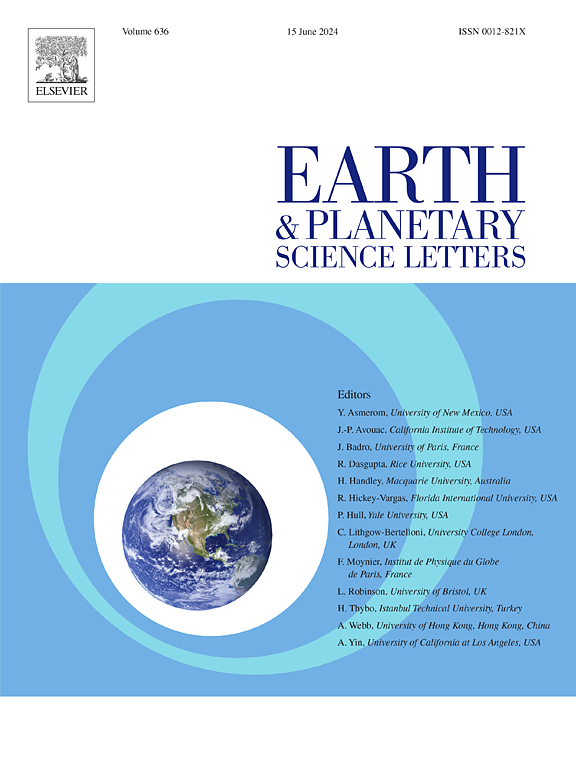Tectonic and climatic controls on late Cenozoic intra-arc basin development in the central Andes of southern Peru
IF 4.8
1区 地球科学
Q1 GEOCHEMISTRY & GEOPHYSICS
引用次数: 0
Abstract
Intra-arc basin strata document the interplay between tectonics and climate in the central Andes. This is exemplified by a shift from fluvial to lacustrine-evaporitic depositional environments recorded in the 2.6 km-thick siliciclastic-carbonate basin fill of the Tincopalca Basin located in the Western Cordillera of southern Peru (∼16°S). Detrital zircon U-Pb geochronology yields age distributions dominated by syndepositional volcanism; maximum depositional ages bracket deposition between 28 and 21 Ma. A decrease in lacustrine carbonate δ18O values from ∼0 ‰ to -9 ‰ at 22–21 Ma, synchronous with lithologic evidence for basin closure can be explained by two nonunique interpretations: (1) prior attainment of high elevations in the Eastern Cordillera and attendant westward penetration of isotopically depleted eastern moisture, and/or (2) attainment of sufficient elevation in the Western Cordillera to exclude enriched western moisture. Results do not discriminate between rapid, large-magnitude surface uplift versus attainment of a threshold, moisture-blocking elevation in the Western Cordillera. Zircon εHf(t) in the Western Cordillera increases from -8 to 0 between 25 and 18 Ma, consistent with formation and subsequent removal of a lithospheric instability. Combining new and published data highlights the complex interactions between tectonics and climate in the following scenario. (1) Instability formation drove basin subsidence at 28–20 Ma. (2) Instability removal slowed subsidence during a transition to depleted eastern moisture, coeval with increasing zircon εHf(t) at 20–17 Ma and concomitant rapid surface uplift at 18–16 Ma. (3) Basin ponding and aridification occurred after 16 Ma in a deepening central Andean rain shadow.
秘鲁南部安第斯山脉中部晚新生代弧内盆地发育的构造和气候控制
弧内盆地地层记录了安第斯山脉中部构造和气候之间的相互作用。在秘鲁南部西科迪勒拉(~ 16°S)的廷科帕尔卡盆地(Tincopalca basin)的2.6 km厚的硅塑料-碳酸盐盆地填充物中记录的从河流沉积到湖泊蒸发沉积环境的转变就是例证。碎屑锆石U-Pb年代学显示同沉积火山作用主导的年龄分布;最大沉积年龄为28 ~ 21 Ma。22-21 Ma湖相碳酸盐岩δ18O值从- 0‰降至-9‰,与盆地闭合的岩性证据同步,可以用两种非独特的解释来解释:(1)东部科迪勒拉先前达到高海拔,并伴随着同位素枯竭的东部水汽向西渗透,和/或(2)西部科迪勒拉达到足够的海拔,以排除西部富集的水汽。结果表明,在西科迪勒拉地区,快速、大幅度的地表隆起与达到阈值、阻湿海拔之间没有区别。西科迪勒拉的锆石εHf(t)在25 ~ 18 Ma之间从-8增加到0,与岩石圈不稳定性的形成和随后的消除一致。结合新的和已发表的数据,在以下情景中突出了构造和气候之间复杂的相互作用。(1) 28 ~ 20 Ma失稳地层驱动盆地沉降。(2)不稳定的去除减缓了东部水汽枯竭过渡期间的沉降,与20 ~ 17 Ma时锆石εHf(t)的增加和18 ~ 16 Ma时伴随的地表快速抬升同步。(3) 16ma以后,安第斯山脉中部雨影加深,盆地积水和干旱化发生。
本文章由计算机程序翻译,如有差异,请以英文原文为准。
求助全文
约1分钟内获得全文
求助全文
来源期刊

Earth and Planetary Science Letters
地学-地球化学与地球物理
CiteScore
10.30
自引率
5.70%
发文量
475
审稿时长
2.8 months
期刊介绍:
Earth and Planetary Science Letters (EPSL) is a leading journal for researchers across the entire Earth and planetary sciences community. It publishes concise, exciting, high-impact articles ("Letters") of broad interest. Its focus is on physical and chemical processes, the evolution and general properties of the Earth and planets - from their deep interiors to their atmospheres. EPSL also includes a Frontiers section, featuring invited high-profile synthesis articles by leading experts on timely topics to bring cutting-edge research to the wider community.
 求助内容:
求助内容: 应助结果提醒方式:
应助结果提醒方式:


